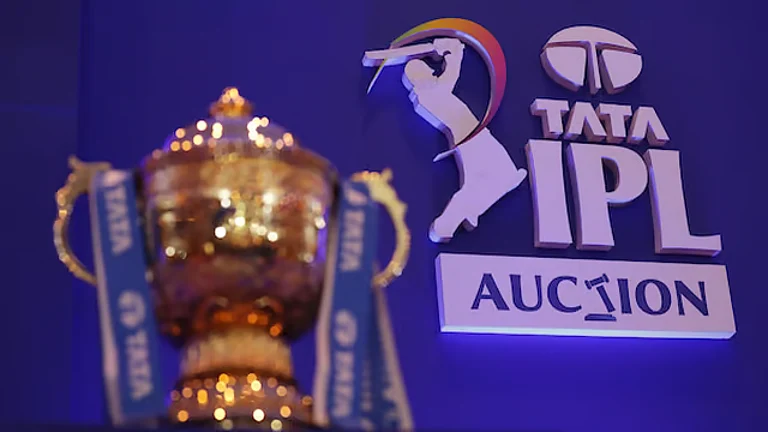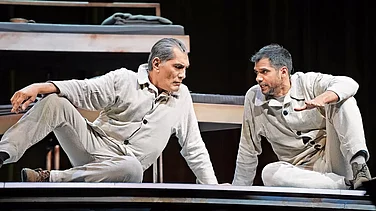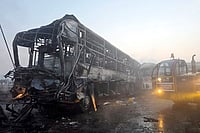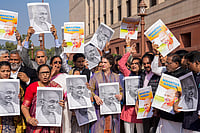What sensory forces inhabit the landscape of childhood? What does it look, sound, feel and taste like? For Palash and Shafikul, two boys growing up in rural Bengal, it looks like fields and rivers to play football and take a dip in; it sounds like the toktoki, a small metallic toy that makes clickety-clack sounds; it feels like catching caterpillars and flying kites. Dostojee (2021), Prasun Chatterjee’s debut film, opens with a childhood scene most of us are acquainted with—throwing pebbles into water. As the two boys try to outdo each other in covering the distance their stones can manage, no boundaries separate them. Yet, a wall appears soon enough, as quickly as the boys—each of whom calls the other by the same name—“Dostojee,” meaning friend—enter their respective houses, separated by a thatched straw wall.
As next-door neighbours, the two boys have about as mainstream a friendship as two village boys could have during ordinary days. Except, the days have ceased to be ordinary. A spectre of suspicion and ill-will pervades the air around them, holding in its sway, the minds and moods of the grown-ups responsible for showing them the way. Dostojee uses the powerful trope of child’s play to convey messages that are anything but child’s play. In fact, this relationship couldn’t be developing at a more fraught time in history. The Babri Masjid, a 16th-century mosque has only recently been demolished in Ayodhya by a mob of Hindutva nationalists, who consider the mosque site to be the birthplace of Rama. This last fact is significant, because, although he’s a part of the region’s folklore, thanks to the epic of Ramayana, Rama isn’t traditionally revered as a god in Bengal. Yet as the wildfire of hurt religious sentiments reaches their village, that is set to change.
Dostojee presents a familiar story—of simmering communal tension—in a remarkably unfamiliar way. To begin with, the story takes place in a Muslim-majority village in West Bengal. This in itself is an interesting alternative to the dominant Hindu perspective one often comes across. When I ask him the reason behind this, Chatterjee tells me, “This comes from my own experience of traveling to areas like the film’s setting in Murshidabad for the last decade-and-a-half, during which time I saw a continuous erosion of harmony between Hindus and Muslims. There’s also another, more subconscious reason. My family came to West Bengal from East Pakistan in the early 1960s in dire circumstances. I tried to imagine what the relations between the two communities could be like, had we been living in a Muslim-majority scenario.”
Even as the battlelines are drawn—with the Muslims vowing to construct a new mosque, one they will call Chhota Babri Masjid, and the Hindus reciprocating by bringing Rama’s idol to the village temple—the graph of the Palash-Shafi (short for Shafikul) friendship maintains an even keel. The affairs of the grown-ups are beyond their understanding; Shafi, for instance, can’t understand why his father won’t allow him to attend a play on Ramayana, when he’d done the same without any fuss the previous year. When he still goes for the play, in stealth, the two friends walk up backstage during the play’s intermission and find the actors playing Rama, Sita and Ravana (all men), sharing a smoking break. The boys are incredulous, and when invited by the actors to enter their tent, Palash finally asks them, “Aren’t you each other’s enemies?” The response of the actors—“No, we are friends. We only act as if we were enemies, all for the belly’s sake, you see?”—is one of the many subtle shrapnels director Chatterjee uses to make his point about organised religion and orchestrated clashes. This subtle artistry of getting the message across, where words and images have both external and internal meanings, makes Dostojee compelling yet poetic in the way great cinema is meant to be.
In the ceaseless romanticising of childhood, it is often overlooked that it is also a difficult territory. In a world governed by adults, children have to constantly look for workarounds, wiggling out ways to protect their little worlds while appearing to be abiding by the laws laid down for them. That is how childhood survives, by negotiating, but as Dostojee shows, also by subverting. And so, even as Shafi goes to see the Rama play despite being forbidden, Palash too, quietly brings an Eid treat from his friend’s house, hiding it from his mother’s eyes, for his little sister. And on the eve of the Hindu festival of Janamashtami that celebrates the birth of Lord Krishna, Shafi comes over to Palash’s house to decorate the jhulan—an ornamental swing depicting various episodes from Krishna’s life. It is an activity kids in Bengal take great joy in, and while Shafi’s innocent participation in an activity associated with a religion other than his own might not seem all that incongruous, what makes it noteworthy is Shafi’s sourcing of mud for the purpose—from the soil for the proposed new mosque.
One could watch Dostojee for its visuals alone—Chatterjee spoils the viewer in that department, with scene after stunning scene representing not only the beauty of rural Bengal, but of the particular joy of growing up there. In one scene, the two children are seen in a wide open field in the evening, wearing something similar to chef’s hats on their heads. Except, these are paper hats Shafi has made using scrap. They look ordinary up until the moment the hats achieve what their maker intends them to—gleaming with fireflies that stick to the adhesive Shafi has plastered the hat with. Even the word magic falls short to describe this scene—two boys laughing and dancing with a thousand fireflies crowning their heads as dusk descends—and its visual thrill. Then there are the more familiar and enduring images of rural Bengal—endless paddy fields, lush monsoons, village fairs and the bioscope as well as repetitive sights and sounds of weaving—the source of livelihood for Shafi’s family.

One of the most telling images in the film is of Pagla, the village madman—sitting silently on a platform attached to a wall, the two halves of which have posters calling for the solidarity of Hindus and Muslims respectively. The madman isn’t a new idea, but even for an oft-used trope, this single wordless scene—depicting insanity as the only balance holding warring groups of religious fanatics in place—is as powerful as it gets in terms of visual coding.
Even as the two boys float—for “rise” is too lofty a word for the natural ease with which they bond—above the discord festering around them, there comes a point when they too must be separated. On an evening of torrential downpour when the boys dip into the river and begin “catching” fish with as much as Palash’s bare hands and the shirt Shafi has stripped himself of, Palash drowns, taking with himself Shafi’s privilege of uttering the word “Dostojee” ever again.
From this moment on, Shafi’s life wouldn’t be the same, of course, but Shafi himself won’t be the same person either. He would give up his waywardness and turn into the diligent student that Palash was, focusing on his lessons and reaching school on time. His friend’s death would make him obsessed with how fish can swim freely in water without drowning. When his home tutor illustrates for him how the fish’s body is designed to draw oxygen from water, Shafi, who had always been the more hands-on of the two friends, decides to invent a machine that would allow humans to similarly take in oxygen when in water.
Shafi would be diligent about one more thing—perhaps the most important of them all—keeping alive a project he and Palash had started together—making a butterfly from a caterpillar. Braving the awkwardness that comes with having to face Palash’s parents, he keeps returning to their house to put fresh leaves into the jar in which they had put the caterpillar. The manner in which this simple act of childhood play is turned into metaphor is yet another testament to Chatterjee’s ability to turn the ordinary into the sublime. Gripped by the memory of the caterpillar, as Shafi comes running to Palash’s house late one evening, we see in the lantern’s dim flicker, how the caterpillar’s movement inside the glass jar catches the attention of Palash’s mother. Transcending itself, the tiny creature now becomes a symbol—of something that breathes and moves, and something that carries a bit of her son in its aliveness. She begins feeding it, and the day Shafi releases the fully formed butterfly, she is seen breaking down for the first time since her son’s death. The suddenness of the insect flying out of the jar hits too close to home.
It is perhaps in the film’s final scene—ambiguous, magic-realist, open-ended—where the stylistic panache of Chatterjee comes full circle, albeit inconspicuously. As a reward for doing well in the final exams, Shafi’s home tutor offers to take him around the village on his bicycle. Shafi requests to be taken to the mango orchard he used to visit with Palash. Once there, he comes across the tree on which the two friends had carved the word “Dostojee”. The film could have ended here and made its point, but it doesn’t. As he looks around, Shafi hears the sharp, unmissable call of the koel, filling the air with its drawn-out koos. Soon enough, Shafi returns the call with a koo sound and the bird responds with an even sharper call. This calling game goes on for a while, until Shafi, not the bird, becomes the primary caller. The entire exercise is about the echoing of the same sound by the bird and Shafi. Exactly like the echo he and Palash used to exchange every day when they called each other “Dostojee.” The film reminds us that this is how friendship lives on—as echoes and shadows—even when friends don’t.
Telling larger stories through the prism of childhood friendship is a delicate exercise and the execution is where the filmmaker’s facility and skill are tested. As in the case of the Chilean film, Machuca (2004), written and directed by Andrés Wood that depicts a friendship developing between two boys distanced by class during the months leading up to the coup d’état led by General Augusto Pinochet, or Julie Gavras’s French-Italian film, Blame It on Fidel (French: La Faute à Fidel; 2006), with a nine-year-old protagonist who must negotiate the world of her activist parents acting as liaisons for Chilean supporters of Salvador Allende, alongside that of her Catholic school and grandparents, Dostojee, too, does a superbly nuanced telling of how children separated by religion are able to keep the faith while working their way through the rough road of bigotry and distrust.
(This appeared in the print edition as "Friendship in the Time of Mistrust")
(Views expressed are personal)
Bhaswati Ghosh is a writer & translator whose first novel, victory colony, 1950, was published in 2020






















